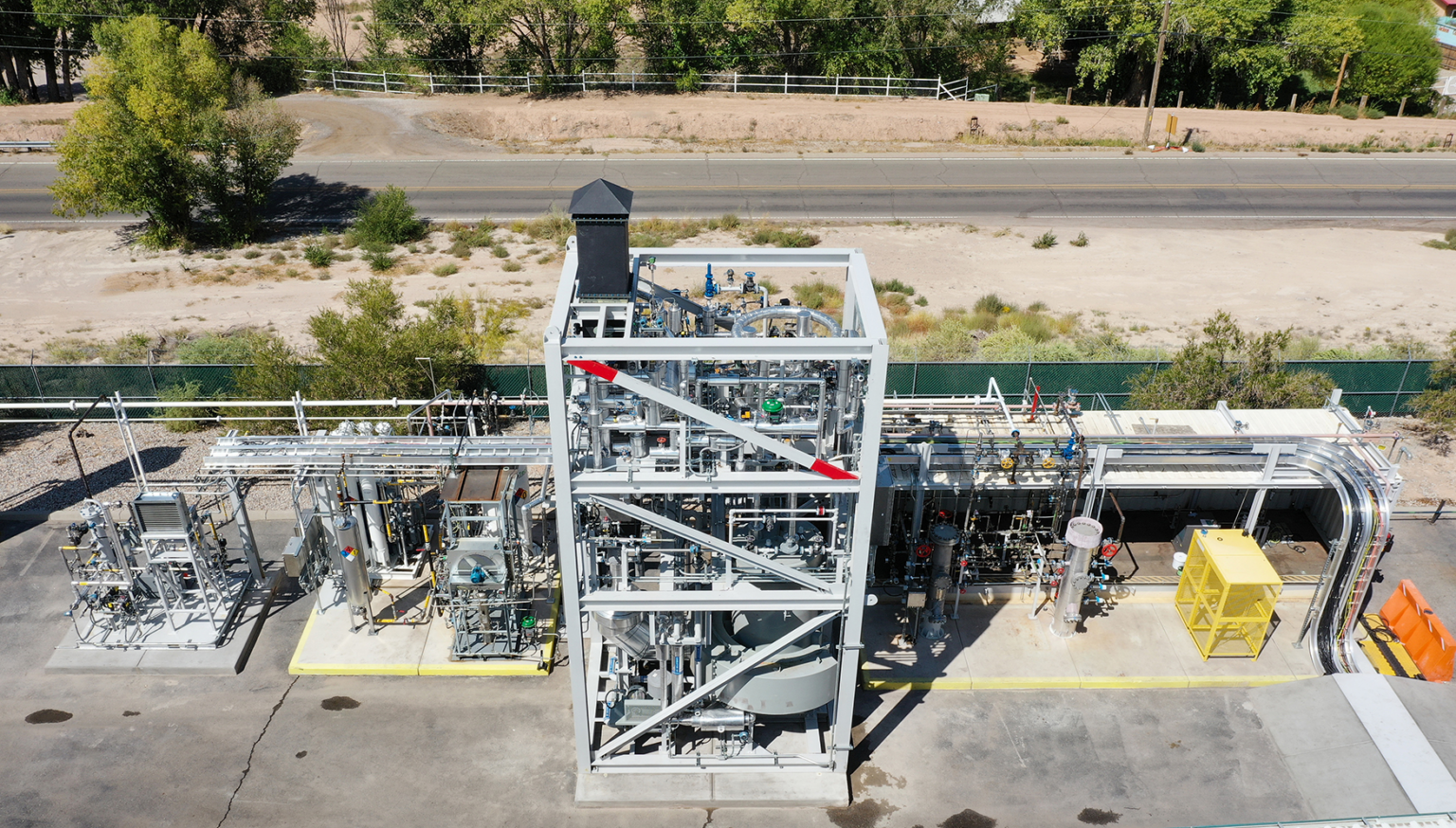Browse components, systems and services for hydrogen industry from leading suppliers on our marketplace!
The hydrogen economy at a glance
A hydrogen energy economy is a vision of a future energy system in which hydrogen plays a central role as an energy carrier. Hydrogen can be produced from a variety of primary energy sources, including fossil fuels, nuclear energy, and renewable energy sources such as solar, wind, and hydroelectric power. It can be used to power a range of vehicles and to generate electricity, making it a versatile and potentially game-changing energy carrier.

Seven building blocks of the emerging hydrogen industry
The structural elements of the hydrogen economy are the technologies and infrastructure needed to produce, store, transport, and use hydrogen as an energy carrier. These hydrogen economy facts represent the main parameters needed to define hydrogen economy development and growth potential. We have identified the following seven building blocks:
- Hydrogen production: Hydrogen can be produced using several different processes, including steam methane reforming, electrolysis, and biomass gasification. Steam methane reforming is currently the most common method of hydrogen production, but it is not renewable and produces carbon dioxide as a byproduct. Electrolysis, on the other hand, is a renewable process that uses electricity to split water into hydrogen and oxygen. Biomass gasification is a process that converts biomass (such as wood or agricultural waste) into a gas that can be further processed to produce hydrogen.
- Hydrogen storage: Hydrogen has a low energy density and is difficult to store in large quantities. It must be stored in high-pressure tanks or as a liquid at cryogenic temperatures. Metal hydrides and chemical compounds such as sodium borohydride and ammonia borane are also being developed as potential hydrogen storage materials.
- Hydrogen transport: Hydrogen can be transported in a variety of ways, including by pipeline, tanker truck, and rail. It can also be transported in liquid form by a tanker ship, similar to the way oil is currently transported.
- Hydrogen infrastructure: The development of a hydrogen infrastructure is key to the widespread adoption of hydrogen as an energy carrier. This includes the construction of hydrogen production facilities, storage and distribution centers, and fueling stations for hydrogen-powered vehicles.
- Hydrogen applications: There are many potential applications for hydrogen as an energy carrier, including the transportation sector, stationary power generation, and the industrial sector. Hydrogen can be used to power fuel cell vehicles, which have a range and performance similar to conventional gasoline-powered vehicles but produce zero emissions. It can also be used to generate electricity through fuel cells or to power industrial processes such as the production of steel and cement.
- Government support: Governments and other stakeholders will need to provide financial incentives and regulatory frameworks to support the development and adoption of hydrogen as an energy carrier.
- Investment: In order to capitalize on the hydrogen economy opportunities and challenges, significant investment will be required in order to develop the technologies and infrastructure needed to support its growth and maturity. This investment will need to come from a range of sources, including private investors, hydrogen economy companies, venture capital firms, and public institutions.
The development of a hydrogen-based economy is still in its early stages, but it has the potential to transform the way we produce and use energy. While there are still challenges to be overcome, such as the high cost of hydrogen production and the lack of a comprehensive hydrogen infrastructure, the potential benefits of a hydrogen-based energy system are significant. It could help to reduce our reliance on fossil fuels, lower greenhouse gas emissions, and increase energy security.
The potential of hydrogen economy at its core is sector coupling
Sector coupling refers to the integration and interconnection of different sectors within an energy system, such as the electricity, transportation, and industrial sectors. In the context of the hydrogen energy economy, sector coupling refers to the integration of hydrogen production, storage, transport, and use across these different sectors.
One key aspect of sector coupling in the hydrogen-based economy is the use of excess renewable energy to produce hydrogen through electrolysis. Renewable energy sources such as solar and wind power are often intermittent, meaning that they do not produce a constant stream of electricity. During times of excess renewable energy production, this excess electricity can be used to produce hydrogen through electrolysis, which is a process that uses electricity to split water into hydrogen and oxygen. The hydrogen produced can then be stored and transported to be used in a variety of applications, including as a fuel for transportation and as a raw material or energy source for industrial processes. Another important aspect of sector coupling in the hydrogen economy is the use of hydrogen as a flexible energy carrier, able to be used in a variety of sectors and applications.
The development of a comprehensive hydrogen infrastructure is key to enabling sector coupling within the hydrogen energy economy. This includes the construction of hydrogen production facilities, storage and distribution centers, and fueling stations for hydrogen-powered vehicles. It also includes the development of standardized protocols and regulations for the production, storage, transport, and use of hydrogen.
There are several potential benefits to sector coupling in the hydrogen economy. It can help to increase the utilization and efficiency of renewable energy sources, as excess renewable energy can be stored and used in other sectors. It can also help to reduce greenhouse gas emissions, as hydrogen produced from renewable energy sources has the potential to replace fossil fuels in a variety of applications. Additionally, sector coupling in the hydrogen-based economy can increase energy security, as it diversifies the energy mix and reduces reliance on a single energy source.
Despite the potential benefits of sector coupling in the hydrogen economy, there are also challenges to overcome. These include the high cost of hydrogen production, the need to build a comprehensive hydrogen infrastructure, and the requirement for standardization and regulation. However, with continued research and development, these challenges can be surmounted and the potential benefits to be derived from sector coupling in the hydrogen energy economy can be realized.

Example – Hydrogen production infrastructure for development of hydrogen economy
Learnings for the hydrogen economy from the solar and wind industry
Comparing the solar and wind industry
The global solar and wind industries have both experienced significant growth and maturity in recent years. This was driven by a range of factors. Some of the key success factors that have contributed to the growth and maturity of these industries are:
- Government support: Governments have played a crucial role in the development of the solar and wind industries by providing financial incentives, setting renewable energy targets and standards, and establishing regulatory frameworks. These policies have helped to create a supportive environment for the deployment and adoption of solar and wind energy.
- Reduction of costs: The costs of solar and wind energy have decreased significantly in recent years, thanks to technological advancements, economies of scale, and increased manufacturing efficiency. This has made solar and wind energy more competitive with other energy sources, and has contributed to their growing adoption.
- Improvements in technology: Both the solar and wind industries have benefited from advances in technology, which have increased the efficiency and reliability of solar panels and wind turbines. These improvements have made solar and wind energy more cost-effective and have contributed to their growing adoption.
- Increasing consumer demand: There has been a growing demand for renewable energy from both individuals and businesses, driven by concerns about climate change and the desire to reduce reliance on fossil fuels. This demand has helped to drive the growth of the solar and wind industries.
- Investment: The solar and wind industries have attracted significant investment from a range of sources, including private investors, venture capital firms, and public institutions. This investment has helped to fund the development of new technologies and projects and has supported the growth and maturity of these industries.
While these success factors apply equally to the solar and wind industries, there are also some differences between the two. For example, the solar power industry is more geographically diverse, with significant solar capacity in a range of countries around the world, while wind power generation is more concentrated in a few key markets. Additionally, the solar industry has benefited more from government support in the form of financial incentives and subsidies, while the wind industry has relied more on regulatory frameworks and renewable energy targets.
Lessons for the hydrogen economy
The growth and maturity of the solar and wind industries have been driven by a combination of technological advancement, reduction of costs, increase of consumer demand, and government support. As these industries continue to mature and expand, it is likely that they will continue to benefit from these success factors, as well as new technologies and innovations that emerge in the future. Therefore, it is important for the hydrogen industry to learn these lessons at an early stage and apply these lessons in building the green hydrogen economy.
Scaling-up the hydrogen economy
There are several key factors that will be necessary for scaling up the hydrogen economy, so to realize its full potential. These include economic prerequisites, incentive measures, and digital tools.
1. Economic prerequisites
One key factor in scaling up the hydrogen economy is reducing the cost of hydrogen production. Currently, the majority of hydrogen is produced through steam methane reforming, which is a non-renewable process that generates carbon dioxide as a byproduct. The cost of hydrogen produced through this process is relatively high, making it less competitive compared to other energy sources. However, the development of renewable hydrogen production technologies, such as electrolysis, has the potential to significantly reduce the cost of hydrogen production.
Another economic prerequisite for scaling up the hydrogen economy is the development of a comprehensive hydrogen infrastructure, including production facilities, storage and distribution centers, as well as fueling stations for hydrogen-powered vehicles. The construction of this infrastructure will require significant investment, which will need to be justified by the potential benefits of a hydrogen-based energy system.
2. Incentive measures
In order to encourage the adoption of hydrogen as an energy carrier and drive the growth of the hydrogen economy, governments and other stakeholders may need to implement a range of incentive measures. These could include subsidies, tax credits, and other financial incentives for the production and use of hydrogen, as well as regulations and standards that favor hydrogen over other energy sources.
3. Digital technologies & B2B platforms
Digital technologies and tools will likewise be critical to the scaling up of the hydrogen economy. These could include advanced modelling and simulation tools that can optimize the design and operation of hydrogen production and storage systems, as well as digital platforms that facilitate the trading and distribution of hydrogen, such as B2B marketplaces.
Hyfindr.com is the leading B2B marketplace for the global hydrogen economy.
Other digital technologies, such as the Internet of Things (IoT) and the blockchain, could also be used to improve the efficiency and transparency of the hydrogen supply chain.
Scaling up the hydrogen-based economy will require a coordinated effort from a range of stakeholders, including governments, industry, and academia. It will also require significant investment in the development of new technologies and infrastructure. However, with the right policies and incentives in place, and the use of digital tools to optimize the production and use of hydrogen at full potential is possible.
Six growth indicators in the hydrogen economy
There are several macroeconomic indicators that can be used to measure the worldwide growth of a new emerging industry like the global hydrogen economy. These indicators can provide valuable insights into the performance of the industry and help to make informed decisions on policy. The six key KPIs that could be monitored closely in order to measure the global growth of the hydrogen energy economy are:
- Gross value added: Gross value added (GVA) measures the value that an industry generates through its production and sale of goods and services each year. It is an important indicator of an industry’s growth and is typically measured as a percentage of GDP. To measure GVA for the hydrogen economy, data on the total value of hydrogen production and sales worldwide could be collected and analyzed.
- Employment: The number of people employed in an industry can be a good indicator of its growth. A growing industry will typically create more jobs, while a shrinking industry will offer fewer jobs. To measure employment in the hydrogen economy, data on the number of people working in hydrogen production, storage, distribution, and end-use applications could be collected and analyzed.
- Exports: The exports of an industry can be a good indicator of its growth, as they show how much of the industry’s production is sold overseas. A growing industry will typically sell more products overseas, while a shrinking industry will sell fewer products overseas. To measure exports in the hydrogen economy, data on the value and volume of hydrogen industry exports could be collected and analyzed.
- Revenues: Revenues refer to the amount of money generated through the sale of goods and services. They are an important indicator of an industry’s growth and are typically measured as a percentage of GDP. To measure revenues in the hydrogen-based economy, data on the value of hydrogen sales could be collected and analyzed.
- Investment: Investment in a new industry can be a good indicator of its growth, as it shows how much money is being put into the development and expansion of the industry. A growing industry will typically attract more investment, while a shrinking industry will attract less investment. To measure investment in the hydrogen economy, data on the value and sources of investment in hydrogen production, storage, distribution, and end-use applications could be collected and analyzed.
- Carbon dioxide emissions: A hydrogen-based economy has the potential to significantly reduce greenhouse gas emissions, because hydrogen can be produced using renewable energy sources and does not emit carbon dioxide when it is burned. To measure the impact of the hydrogen economy on carbon dioxide emissions, data on the carbon dioxide emissions associated with hydrogen production and end-use applications should be collected and analyzed.
Last update: 04.07.2023









